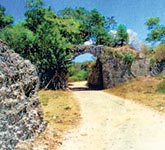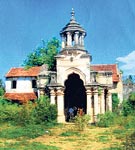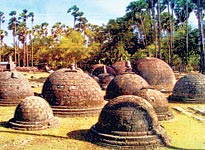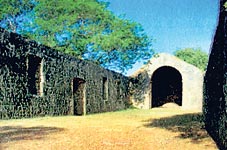They are remains of dilapidated edifices with bullet-riddled walls, overgrown with trees, abandoned and neglected- some centuries old. Many are the monuments and sites of archaeological importance in Jaffna that still stand, though battered and broken, mute testimony to the impact of the country’s three decades-long bitter war.
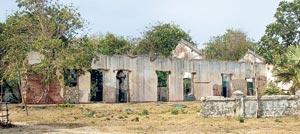 |
| Queen’s House of the Jaffna Fort |
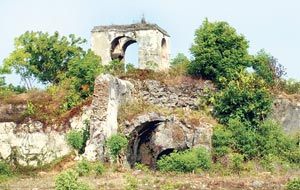 |
| A bell tower within the
Jaffna Fort |
However, as a new chapter in the history of Sri Lanka begins with the dawn of peace, efforts are being made to return the war-torn areas to normalcy and it is in this back- drop that archaeological and historical sites in the north have been identified to undergo a face lift.
Officer in charge -Immediate and Special Explorations—Exploration and Documentation Division of the Department of Archaeology, T. M.C. Bandara said after the conclusion of the war, Archaeological Department teams visited the North on two occasions, mainly to identify the historically important sites before the launch of development activities under the Uthuru Wasanthaya programme. He also said that these sites will play a vital role as tourist attractions after these areas have been developed.
The remains of the Portuguese-built Jaffna Fort, which is also considered the second biggest Fort in Sri Lanka, and the moat around it, is one which, according to Mr. Bandara, can be renovated and preserved as an archaeological monument, although parts of it have been damaged due to heavy shelling during the conflict. Built on coral bricks, its ramparts have not been heavily damaged. The moat and the five bastions are overgrown with trees and plants as it had been abandoned during the war.
The Fort was used until 1984, Mr. Bandara said. There have been various buildings inside the Fort such as a church, and tunnels which are believed to have been a storehouse where arms and equipment were kept as well as several ponds (diya agal). “The church walls have collapsed so we are looking to identifying the foundation of the church at least,” he said.
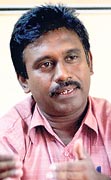 |
| T. M.C. Bandara: Looking forward to the project |
Inside the Fort is also the Queen’s House where past presidents had stayed during their visits to Jaffna in the 80’s. This building which is about 60 metres long and 80 metres wide, however, is in good condition with only its roof having been destroyed.
With the help of an aerial photograph which was taken earlier when it was in good condition, Department officials have been able to identify the shape of its roof and several damaged pillars in the open verandah. As such this building can be renovated to its original state. The renovation would not be only limited to maintaining it as a relic of the past but also to make it a usable building, the official stressed.
The Fort and the Queen’s House will be developed in the first phase of the renovation programme, he added.
The Manthri Walauwa where the last ancestors of the Sangilian Royal family dwelt is yet another significant archaeological site in the Nallur area, says Mr. Bandara. It was believed King Sangilian ruled Jaffna during the reign of King Parakramabahu VI in Kotte. “There hasn’t been massive damage to this king’s abode although it is overgrown with trees and plants.
In the vicinity of the Sangilian compound are various small monuments such as the foundation of the Sangilian Palace, the Yamuna pokuna and the entrance which is in the form of a thorana. “In fact there was evidence to the effect that the LTTE has put up a shelter with asbestos sheets and iron spikes at this entrance,” he said.
Located on the Jaffna- Kankesanthurai road is the Chankanai church which was built during the Dutch period. What is found today are the church altar, some of its side walls and arches.
“During the Cease Fire Agreement, we visited this church. It was being maintained by the Archaeological Department and therefore it is in a good condition today,” he said adding that its walls which were damaged due to the tree roots will be restored through the use of chemical treatment.
The Kadurugoda Buddhist temple in Jaffna which is also known as Kantarodai is of significant religious importance due to around 40 small and medium-sized dagobas found among its artefacts.
In addition to these main archeological sites around Jaffna, there are a number of houses and other buildings of archeological importance in the area, belonging to the Dutch and English periods in particular that are yet to be explored, the official said, looking forward to the development ahead.
|
| Entrance to Jaffna Fort |
|
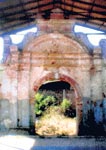 |
| The Manthri Walauwa |
The Sangilian Palace |
|
| The little Dagobas of Kadurugoda Buddhist temple |
|
| Chankanai church |
|




